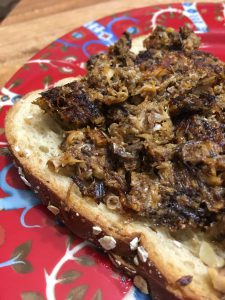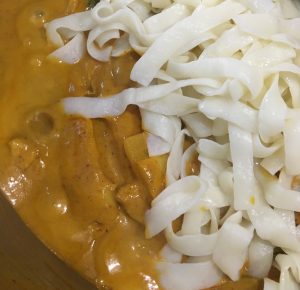 Experimenting with tofu shirataki noodles (shirataki is made of yam, and is extremely low-carb, low-calorie, and gluten-free); here I added them to a simple Thai yellow curry.
Experimenting with tofu shirataki noodles (shirataki is made of yam, and is extremely low-carb, low-calorie, and gluten-free); here I added them to a simple Thai yellow curry.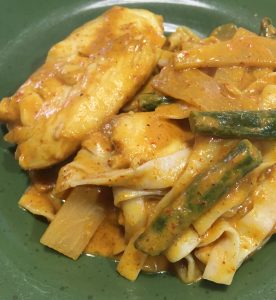
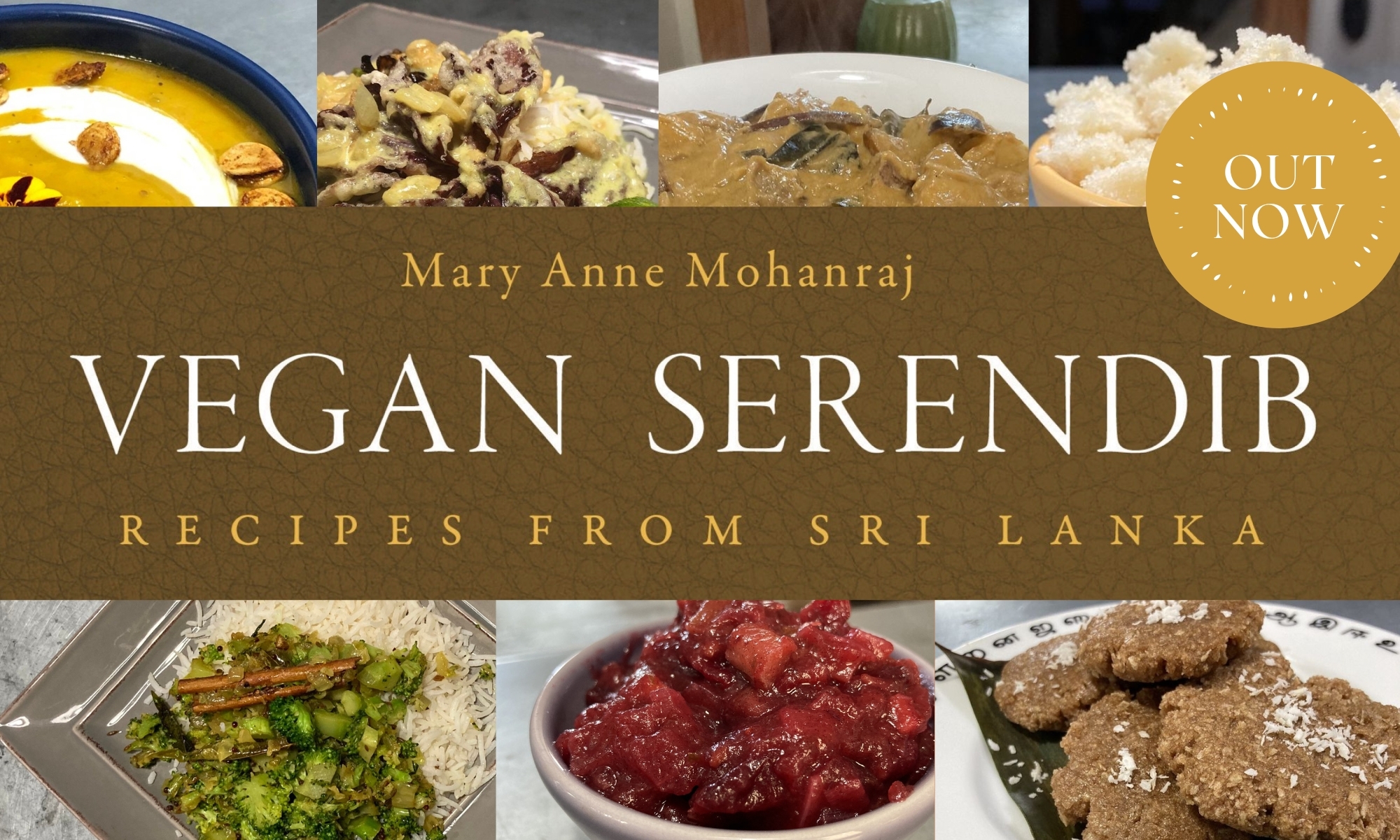
with Mary Anne Mohanraj
 Experimenting with tofu shirataki noodles (shirataki is made of yam, and is extremely low-carb, low-calorie, and gluten-free); here I added them to a simple Thai yellow curry.
Experimenting with tofu shirataki noodles (shirataki is made of yam, and is extremely low-carb, low-calorie, and gluten-free); here I added them to a simple Thai yellow curry.
 Five minute dinner — well, mostly because of leftovers and accompaniments. I had some rice + quinoa leftover from yesterday, and a little kale salad, and of course, I try to keep myself stocked with coconut sambol and seeni sambol in jars in the fridge.
Five minute dinner — well, mostly because of leftovers and accompaniments. I had some rice + quinoa leftover from yesterday, and a little kale salad, and of course, I try to keep myself stocked with coconut sambol and seeni sambol in jars in the fridge.
So all I had to do was throw a tablespoon of butter in a hot pan, add a few tilapia filets, grind salt and pepper over them, flip them over a few minutes later, grind a little more salt and pepper on the other side, and when it was cooked through, serve with the rest of the food. Delish. The tilapia, seeni sambol, and rice/quinoa combo by itself would have been great — the other elements added pleasant fresher notes.
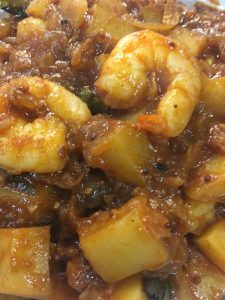 (30 minutes, serves 6)
(30 minutes, serves 6)
I had a busy work day yesterday, so it was six o’clock before I had a chance to look at the calendar and remind myself what the evening plans were — only to be reminded that I’d planned to go to a refugee-supporting potluck, which started at six o’clock!
We were supposed to bring something to share from countries that might be affected by a refugee ban, so I obviously wanted to bring Sri Lankan food. But I needed something I could make fast!
I also ideally wanted to bring a savory dish, and something with protein, because potlucks tend to lean heavy towards the sweets and the starches. I poked around in the freezer and pantry, confirmed I had frozen shrimp and russet potatoes; that meant I had a plan in place. By 6:30, I was transferring the curry into a disposable container and heading out the door; just a few minutes later, people were tucking into the food enthusiastically. Yum.
2 T vegetable oil
1 large onion, chopped fine
2 T ginger-garlic paste
1 t. mustard seed
1 t. cumin seed
1 stalk curry leaves
1 T chili powder
1 t. Sri Lankan curry powder
1/4 c. ketchup
1 t. salt
1 lb. frozen peeled raw shrimp
1 lb. russet potatoes, peeled and cubed small
1 T lime juice
1. Put potato cubes in a microwave-safe bowl with water to cover and microwave 5 minutes to par-boil. Let sit until needed.
2. While potatoes are microwaving, sauté onions in oil or ghee with ginger-garlic paste, mustard seed, cumin seed, and curry leaves, stirring on high, until onions are golden-translucent, about 5 minutes.

3. Stir in chili powder, curry powder, ketchup, and salt. Stir a minute or two to blend.

4. Add potatoes with their cooking water. Add shrimp (still frozen is fine). Continue cooking on high, stirring occasionally, until shrimp are cooked and pink, and potatoes are soft.

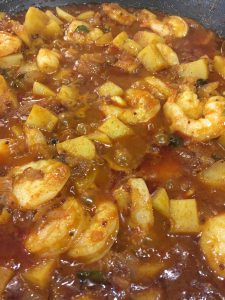
5. Add lime juice, give a final stir or two, and serve hot with rice or bread.
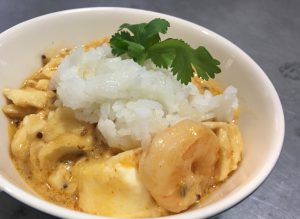 (30 minutes, serves 4)
(30 minutes, serves 4)
Creamy, tangy, richly-spiced, with just a little heat; I was aiming for something my daughter would love. Of course, feel free to amp up the chili powder or toss in some chopped Thai green chilies for a spicier version! Use whatever seafood you have on hand — I pulled some frozen tilapia and shrimp out to toss into this.
1 onion, chopped
1/4 c. oil or ghee
1 T ginger, grated
3 cloves garlic, chopped
1 t. mustard seed
1 t. cumin seed
1/2 t. fennel seed
1/2 t. methi seed
3 cloves
3 cardamom pods
1 stick cinnamon
1/2 t. chili powder
1/2 t. Sri Lankan curry powder
1 stalk curry leaves
2 pounds seafood, cleaned
1 can coconut milk
1 T lime juice
coriander for garnish
1. Saute onions in oil or ghee with ginger, garlic, spices, and curry leaves until onions are golden-translucent, about ten minutes.
2. Add seafood and coconut milk. Bring to a boil, stirring, then turn down heat to medium and cook another ten minutes or so, until seafood is cooked through.
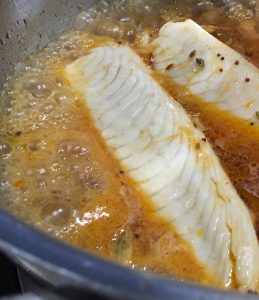
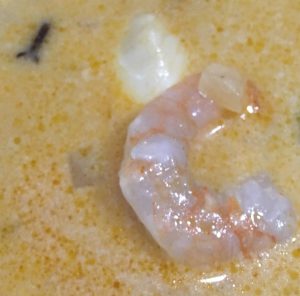
3. Continue cooking until stew is desired thickness. Add lime juice and stir in, then cook a minute or two more. Serve hot with fresh rice and chopped coriander.
With the New Year, I’m trying to more consciously eat plenty of fish (and serve it to my kids). I’ve been eating lox and bagels for years, but only recently have I discovered whitefish salad. I think it was at my friends Ellen and Delia’s apartment in New York, where we had a weekend writing workshop and they laid out a beautiful bagel spread with lox and multiple fish spreads, along with everything else you might want. SO GOOD.
 Next up in the queue is figuring out how to make my own whitefish salad (please do feel free to point me to your favorite recipes!), but for right now, I’m very happy that my local Whole Foods carries ‘whitefish paté’ in their seafood case. Toast a bagel, layer it up with lettuce, tomato, capers, red onion (not pictured, because I was out, but trust me, that makes it even better), and you have yourself a delicious breakfast.
Next up in the queue is figuring out how to make my own whitefish salad (please do feel free to point me to your favorite recipes!), but for right now, I’m very happy that my local Whole Foods carries ‘whitefish paté’ in their seafood case. Toast a bagel, layer it up with lettuce, tomato, capers, red onion (not pictured, because I was out, but trust me, that makes it even better), and you have yourself a delicious breakfast.
(And for those counting calories, if you pile this all on a mini bagel, it’s still only about 200 calories, which is kind of amazing. Have two!)
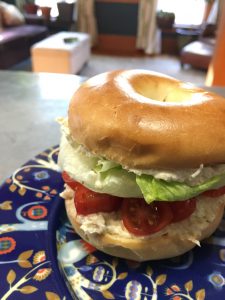
Second meal at Koko Head Cafe as good as the first! I had the delectably creamy poke omelette: fried local poke, masago aioli (SO GOOD), salad, with rice, along with a KHC Sunrise – tequila, bell pepper, orange-pineapple, chili. (I couldn’t really taste the chili, but it was still good.) Jed got a special, the vegetarian luau, I think it was called, a terrific combination of ‘ulu (breadfruit), taro, yam, with a yummy green sauce, a fried egg, and rice, topped with pickles and fried onion. So good.

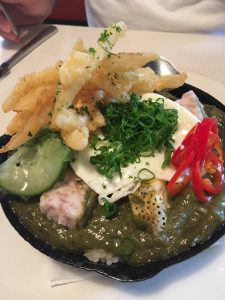
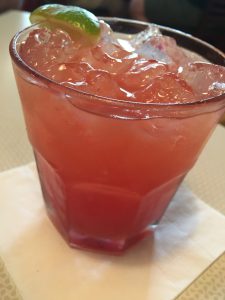
Big thanks to Kavita for the recommendation for Koko Head Cafe — we *loved* it. Had brunch there yesterday, got a scone and muffin to take away for later, and are going back for brunch today because there were just too many delectable-looking things on the menu, and it was too hard to pick.

I got the ‘fish and eggs,’ which is an unassuming name for one of the best dishes I’ve ever had. Sweet miso marinated local fresh fish, soft scrambled eggs, ong choy (water spinach), ocean rice, house made pickles. So, so good. (Also very filling, only finished half of it, but am saving the rest for another meal.)


Jed got the volcano eggs (baked eggs, spicy tomato based sauce, cheddar cheese, choice of daily north shore vegetables or diced Portugese sausage), also yummy, in a more comfort food kind of way.


Kimchi bacon cheddar scone (v. intense flavors, delicious and spicy-salty, but does need juice or tea to cut it, IMHO) & black sesame yuzu muffin (good, complex flavors).
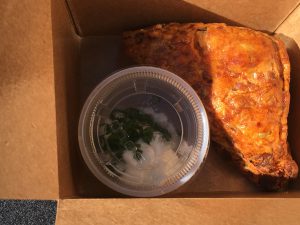
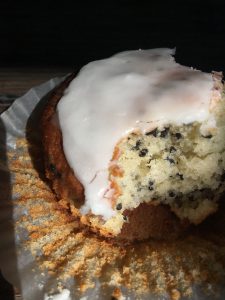
Mas Paan is literally ‘meat bread,’ and is a favorite snack sold at roadside stands, hotel cafes, and transit stations across Sri Lanka. The yeast bread may be filled with whatever curry you like — fish and vegetarian options are also common. This batch, I made with some leftover pork and potato curry, but most often, I would make this with beef and potato curry. Regardless, having thirty mas paan in my fridge and freezer means that I’ll snack happy for a few days, take them with me while traveling — they’re great to have on the road — and be able to pull some out of the freezer to toast up when I get home again. It’s best piping hot, but may also be happily eaten at room temperature.
Note: If you don’t want to make the dough by hand, and your grocery store carries frozen loaves of bread dough, I’ve thawed and used a pair of those for this recipe to good effect. This recipe adapted from Charmaine Solomon’s _The Complete Asian Cookbook_, with very little change.
Note 2: Minal Hajratwala has a fascinating chapter that explores the political significance of similar buns in South Africa, in her book on the diaspora, _Leaving India_. Highly recommended.
Mas Paan
(about three hours + currying time, makes 30)
1 batch meat and potato curry (about 2-3 lbs. meat, 3 russet potatoes)
Dough:
1/2 c. milk
3 t. sugar
2 1/2 t. salt
3 oz. butter
1 1/2 c. warm water
1 packet (about 2 1/4 t.) active dry yeast
5 1/2 – 6 c. all-purpose or bread flour
1. Make curry, if needed; it’s tempting to make it while the dough is proving, but the timing can be tricky, since the curry needs to cool down, and your dough may overprove, turning yeasty. (I admit to risking it on occasion, though, for efficiency’s sake.) The curry should be cooked until it is very dry, and then cooled down to room temperature.

2. Make dough: Scald milk, stir in sugar, salt and butter and cool to lukewarm. Measure warm water into a large bowl; stir yeast into water until dissolved. Add milk mixture and 3 c. of flour; beat until smooth. Add enough flour to make a soft dough. Turn onto a lightly floured board, and knead until smooth and elastic, about ten minutes. Grease a bowl with butter, then put the dough ball in, turning it to make sure it’s all greased. Cover with plastic wrap or a cloth and allow to prove in a warm place until doubled in bulk (inside a turned off oven works well), about 1 – 1.5 hours. (This recipe is also used for making breudher in Sri Lanka.)
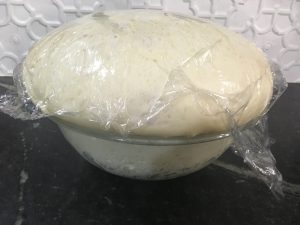
3. Divide the dough into 30 equal portions, flatten each portion to a circle and put a spoonful of meat and potato curry in the center. Bring the edges together, pressing to seal. If you keep the dough thinner at the edges when you’re flattening it, that’ll help keep it from being too bready at the bottom.


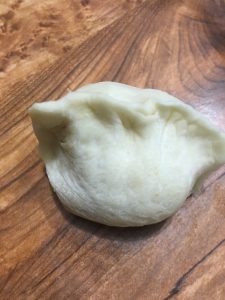
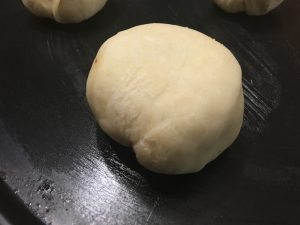
4. Grease baking trays and put buns with the join downwards on the trays, leaving room for them to rise and spread. Cover with a dry cloth and again, leave in a warm place for 30-40 minutes until nearly doubled in bulk.

5. Brush with egg glaze (egg whites or even heavy cream may be used instead) and bake in a hot oven until golden brown, about 10 minutes. Lovely with hot, sweet, milky tea.

I have to admit, I got a little sentimental making cutlets with Kavya this year. I think it’s the first time she and I have done this together, and it reminded me so much of all the years sitting with my mom and sisters and aunts before a party, making these. I told her that, and she said, “So it’s a tradition?” And I said yes. She’s a proper Sri Lankan girl now, even if our cutlets aren’t as perfectly rolled (or the onions as finely diced) as my mother’s would have been.
Fish (or Ground Beef, or Vegetable) Cutlets
(90 minutes, makes about 50)
There’s a part of my mind (formed in childhood over monthly Sri Lankan birthday parties at various aunties’ homes) that says a party isn’t properly a party unless there are rolls and cutlets. So when people agree to come over to my house and let me feed them rolls and cutlets, it makes that childhood bit of me very happy.
Some Americans find these too fishy, but I love them. Over the years, my family has come up with adaptations to suit the tastes of those (like Kevin) who dislike fish, and they’ve even come up with a variation for vegetarians. But honestly, the mackerel ones are the tastiest.
I wouldn’t recommend attempting this recipe unless you’re willing to get your hands dirty (and fishy-smelling)—you really need to work the filling with your hand to blend and shape it properly.
2 cans of mackerel, 15 oz each
2 large russet potato
4 medium onions, chopped fine, for sautéing
1 tsp black mustard seed
1 tsp cumin seed
2 TBL oil or ghee
1 rounded tsp salt
2/3 cup lime juice
2 small onions, minced, for mixing in
4 rounded tsp finely chopped fresh Thai green chilies
1 rounded tsp ground black pepper
2 egg, beaten
dry breadcrumbs, for coating
oil for deep frying
1. Drain fish thoroughly, removing as much liquid as possible. While fish are draining, boil the potatoes, peel, and mash them. Clean the fish, removing scales and bones, and break it into small pieces.
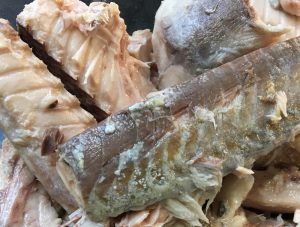
2. Sauté the four fine-chopped medium onions in oil with cumin and black mustard seed until golden-translucent. Add fish, salt and lime juice, then cook until very dry (this process reduces the fishy smell, and the drier you get the mixture, the less excess oil they’ll pick up when frying). Let cool.
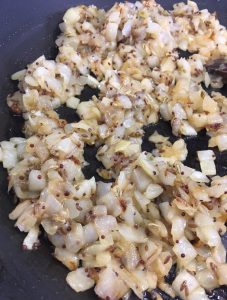
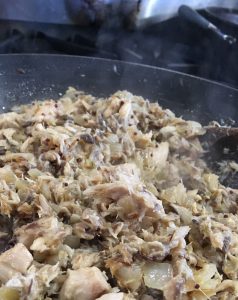
3. Using your clean hand, mix thoroughly the fish, mashed potatoes, the two small minced raw onions, black pepper, and chilies until a fairly smooth paste. Shape the mixture into small balls, about the size of a cupped palm. I squeeze the mixture in my balled hand as I go, compressing so the resulting ball is nice and firm—that helps it keep its form when frying. (You can pause, cover with plastic wrap, and refrigerate at this point if making a day or two ahead.)

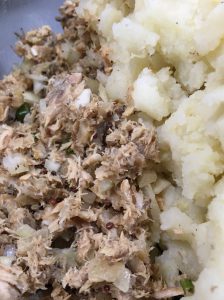
4. Roll each ball in beaten egg, and then roll each ball in the dry breadcrumbs. (You can freeze at this point if making ahead—spread them out on a flat cookie sheet so they’re not touching and freeze them—once frozen, you can pack them more tightly in gallon ziploc bags, and they should hold their shape. They’ll be fine in the freezer for weeks, which helps when you’re prepping for a big party; you can either fry them frozen or spread them out on plates and let them thaw first.)
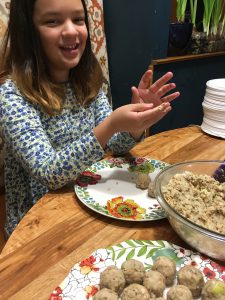
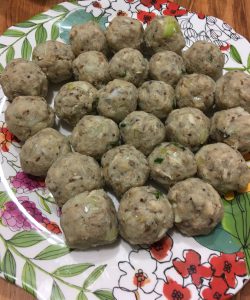

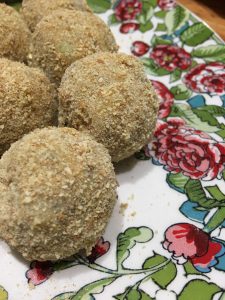
5. Fry a few at a time in deep hot oil over medium-high heat—not too hot, or they’ll start to break apart! This should take a minute or so each. When well-browned, lift out with a slotted spoon and drain on a metal rack placed over a tray lined with a few layers of paper towels.
For ground beef cutlets: For 2 lb lean ground beef, when you sauté the 4 chopped onions, add 1-2 heaping tsp red Indian chili powder and 1/2 cup ketchup, as well as the 1/2 rounded tsp salt from above. Add the ground beef (skipping the lime juice), and fry until very dry, draining any excess oil. Skip the raw onion, chilies and black pepper—proceed otherwise as for the fish cutlets.
For vegetable cutlets: Just use 1 lb frozen mixed vegetables, thawed (you might have to cut up the green beans into smaller pieces). Sauté the onions, mustard seed, and cumin seed as for the fish; add the vegetables and salt and cook until very dry. Skip the raw onion if you like, but definitely stir in an extra 1/2 tsp of salt when you mix the veggies in with the potatoes, black pepper and chilies. Proceed otherwise as for the fish cutlets.
